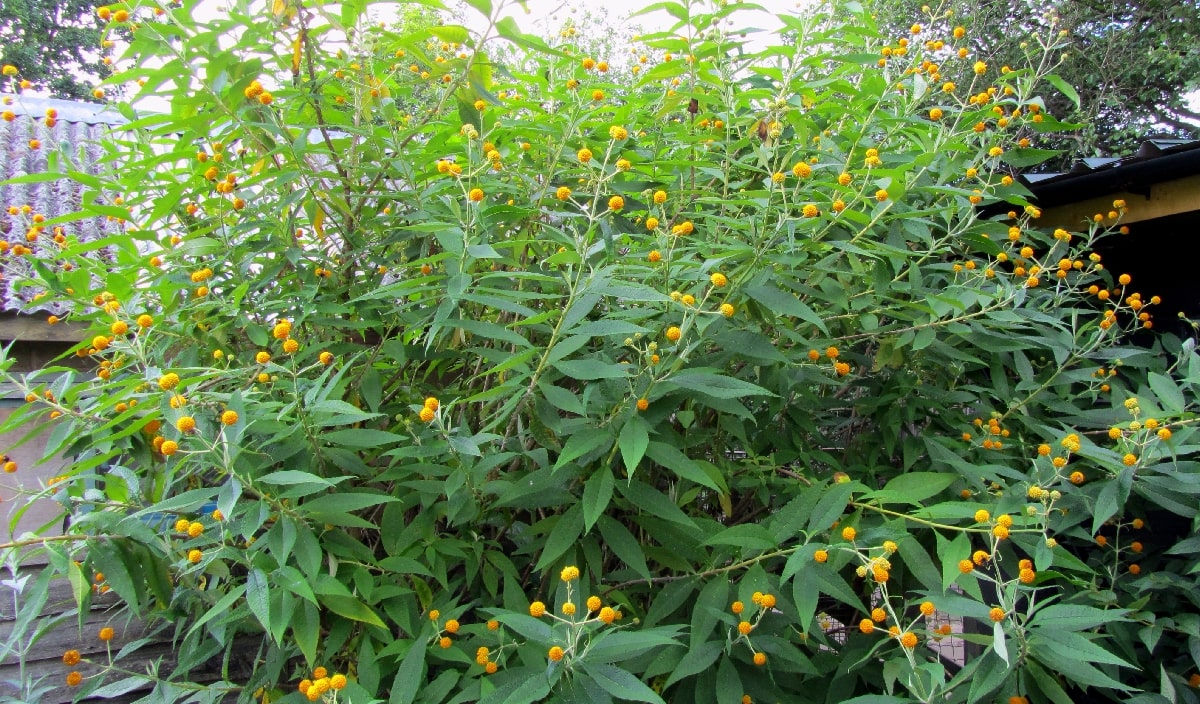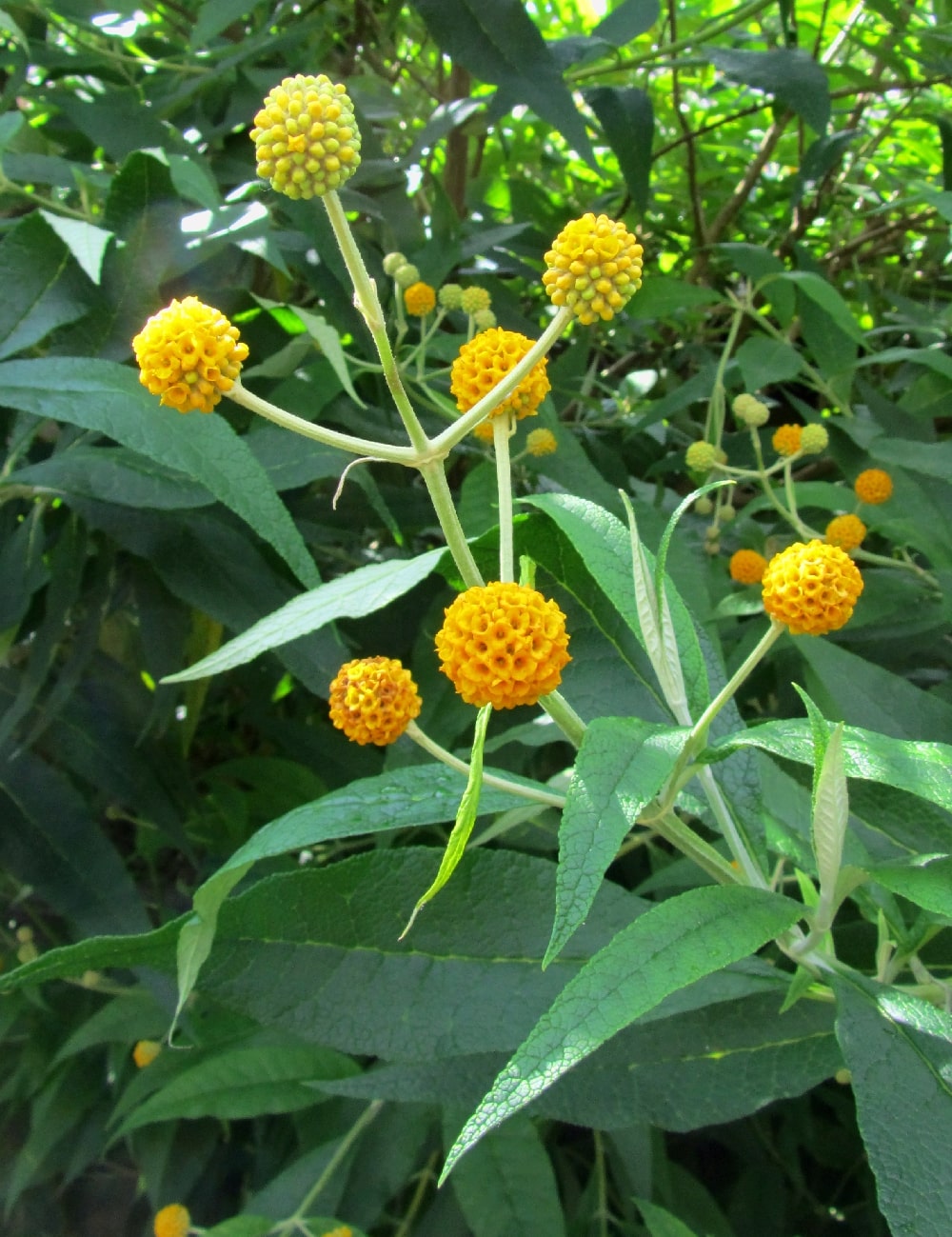
Buddleja globosa and
Buddleja araucana
Revised October 2023
Buddleja globosa Hope
Synonymous species:
Buddleja capitata Jacq.;
Buddleja connata Ruiz & Pav.;
Buddleja globifera Duhamel.
Buddleja globosa is indigenous to the southern Andean region in Chile and the most westerly part of Argentina. It’s a very large shrub with large dark-green green leaves. It flowers in late spring-early summer, depending on cultivar, position and the weather, flowering as early as April and as late as July. The inflorescences are intriguingly golf-ball shaped clusters of 20-30 flowers, each ball about 15-20 mm in diameter; these are arranged in spikes of five to nine flower balls. As a nectar source it is particularly beloved by the bumblebees species, and they will spend hours on the ball-shaped flowers.
The species was described and named by Professor John Hope, an Edinburgh botanist, in 1782. B. globosa was actually the first Buddleja grown as a garden ornamental in England, introduced by the Vineyard Nursery in Hammersmith in the late 18th century, at least a hundred years before B. davidii was seen in English gardens.
The antique illustration shown is by the renowned French botanical artist Pierre-Joseph Redouté, and dates from an 1809 edition of Henri Louis Duhamel de Monceau's Nouveau Duhamel, ou Traité des arbres et arbustes que l'on cultive en France, showing the species was already also being widely cultivated in France by this date.
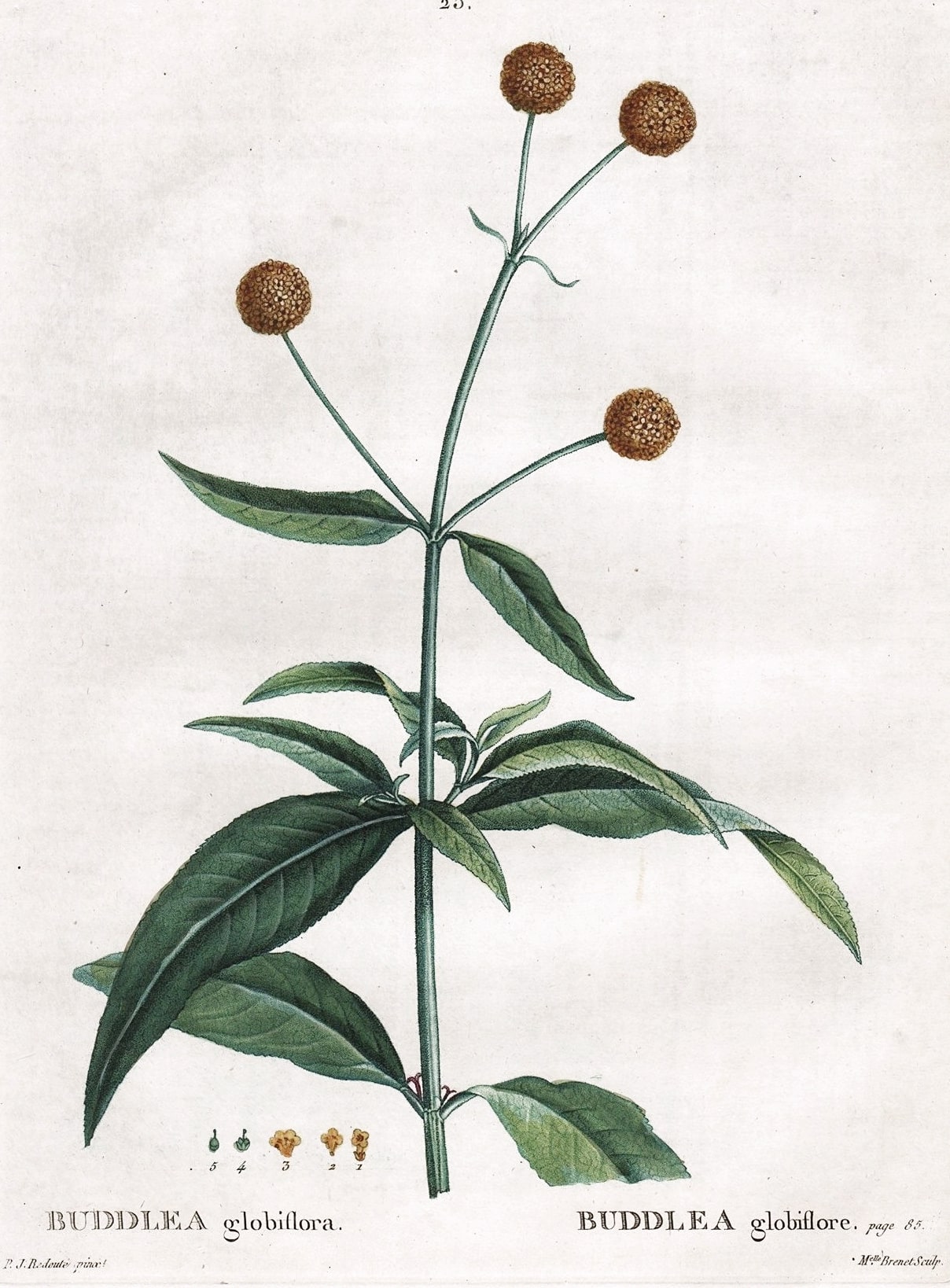
An antique print of B. globosa from 1809.
Open full
size image in a new window
B. globosa is the most popular Buddleja in temperate gardens after B. davidii. The species is hardy and robust, pest-free and long-lived. Lowland UK winters, down to temperatures of -15ºC, will not trouble the shrub even though the foliage will be much reduced. The only persistent danger is wind-rock: in common with most Buddleja, it’s relatively shallow rooted. B. globosa can grow into a big shrub easily reaching 4 or 5 metres in height and width. Large specimens in exposed locations can be blown over, so in such situations reducing the height after flowering may be advisable. Otherwise pruning is only a matter of maintaining the size and shape.
B. globosa, in common with many Buddleja species from the Americas, is a dioecious species – the seed-bearing and pollen-bearing flowers are on separate plants. The plants may for convenience be considered as female (seed-producing pistillate flowers) and male (pollen-bearing staminate flowers).
There is some confusion with B. globosa because the flowers often appear to have both female (pistil) and male (stamens) parts, but one or the other is usually proves to be non-functional on closer examination. This is called cryptic dioecy and species that display this are described as being cryptically dioecious, in older texts this may be described as micro-dioecious.
Matters are further complicated as some male individuals will develop seed capsules under stress, although these often contain no seed. However, viable seed may be produced and this suggests B. globosa might possibly be considered a trioecious species (female, male and hermaphrodite plants). Both HCM 98017 and RCB RA-C-11 (see below) have been known to occasionally develop seed capsules despite their having conspicuous stamens that shed copious pollen.
More on determining the gender of Buddleja can be found below.
Male plants have a reputation for being more showy, often having larger balls and producing more flowers overall. This isn't true for all cultivars, but the generic male I'm familar with certainly is more floriferous than the female.
Seed heads will form from pollinated female flowers during the summer months, ripening in the autumn. The seed capsules will split over the winter when they’ve dried, releasing the tiny wingless seeds. Each capsule contains 50 or more seeds and each cluster is composed of up to 30 capsules, so the potential seed production of a single plant is enormous. However, unlike B. davidii, B. globosa has not proven invasive; this is due in part to the wingless seeds, which do not disperse and spread so easily.
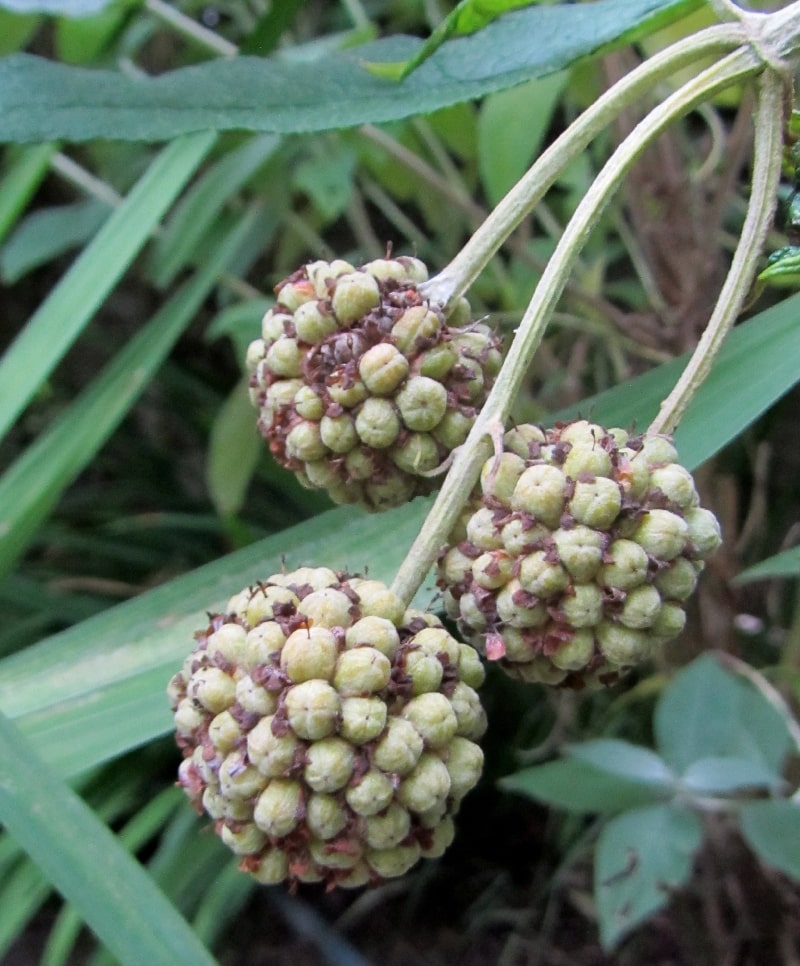
The seed heads of B. globosa are larger than the flowers, up to 2.5 cm in diameter.
Open full size image in a new window
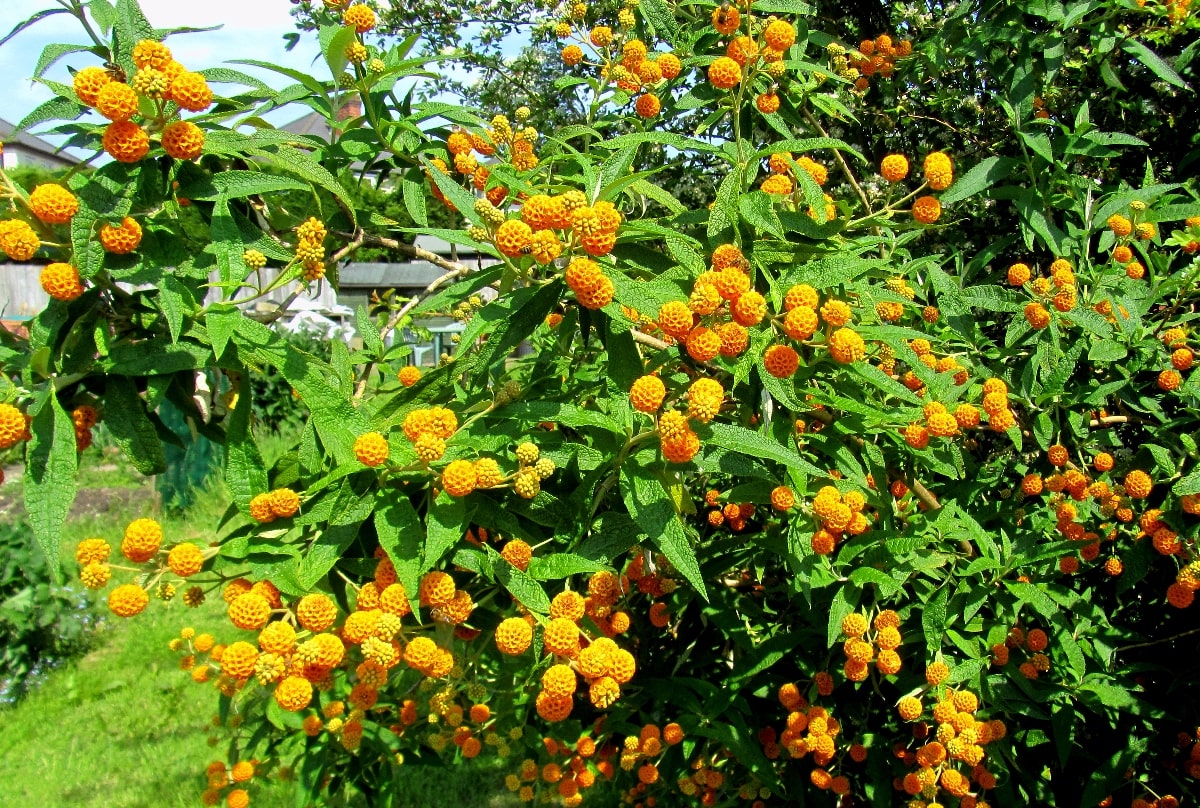
This generic staminate (male) B. globosa is particularly floriferous and the flowers are more showy than the female.
Open full size image in a new window
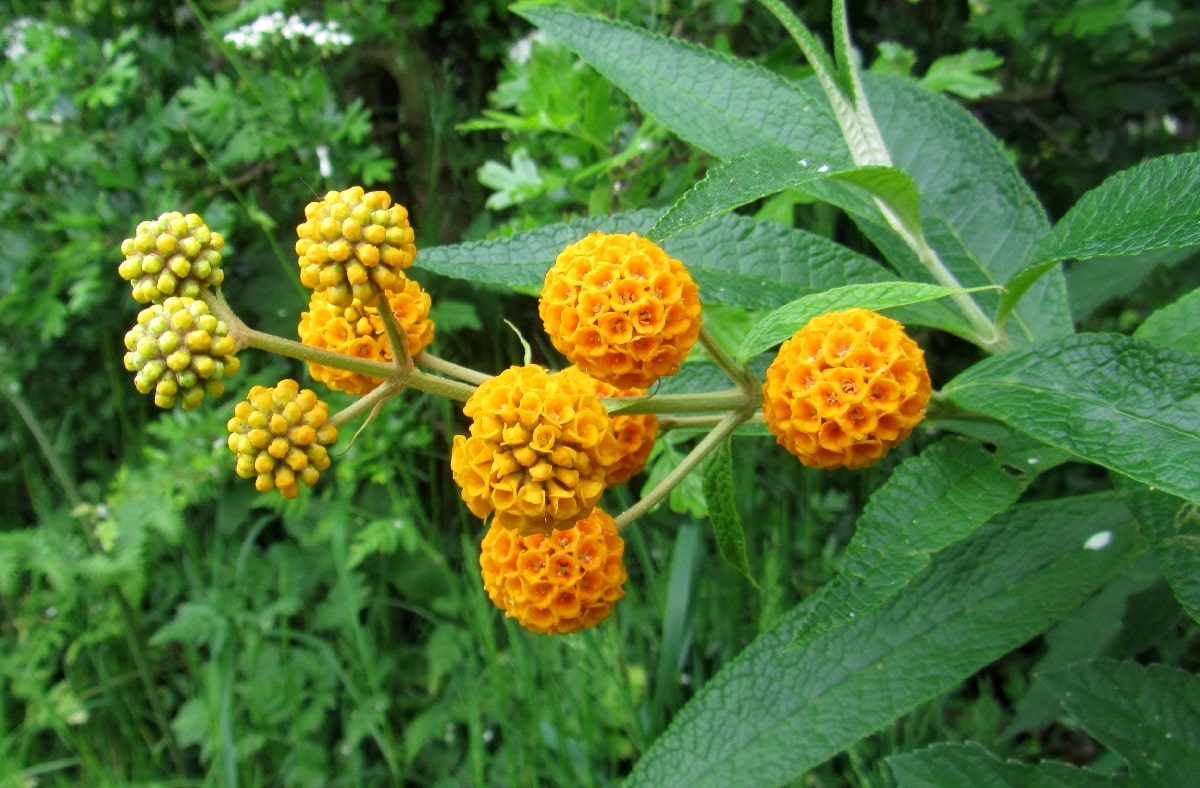
The staminate (male) inflorescence of B. globosa, each spike has up to nine flower heads, each of 20-30 individual flowers.
Open full size image in a new window
There are a few named cultivars of the species. 'Lemon Ball' is the most frequently encountered, although by no means widespread. Smaller and slower growing, it’s not a good performer. The flower spike has fewer balls, sometimes only a single head, and the colour is a dull yellow-orange, not a bright lemon-yellow. I’ve had the chance to closely examine a specimen and can confirm it’s female; I’ve collected and germinated its seeds.
'Cally Orange' is a cultivar selected from a number of seedlings raised by the late Michael Wickenden, of Cally Gardens in Scotland, grown from seed he collected in Chile in 1986. It’s a floriferous selection, with larger flower heads of a superior colour, reportedly a deeper orange than average, but is otherwise typical of the species and most likely a male plant. 'Cannington Gold', raised at the Cannington Walled Gardens in Somerset, is one I haven’t seen offered for sale or represented in any collection, and may be lost to horticulture. Other than being another orange-flowered B. globosa, there is little information on its form. The RHS once also listed a variegated form of the species, but sadly this appears lost also.
In addition to named cultivars, there are several unnamed plants grown from wild collected-seed. RCB RA-C-11 from Cotswold Garden Flowers is a male plant with typical orange balls, but has an earlier and longer flowering period from late April to the end of June.
B. globosa HCM 98017 is rather different and has very pale cream-yellow flowers and smaller leaves. Unfortunately, the flowers aren't really bright and don't show up well against the foliage. Close examination of the flowers leads me to believe that it is a male plant. Under stress, it started to produce a few seed capsules, but these proved devoid of viable seed. CGM 127, collected in 2013, grown at Benmore Botanic Garden (RBGE) in Scotland, also has very pale flowers. There are no doubt other unique specimens in botanical collections, but these are not available to the public and little additional information is available.
There seems to have been little or no effort towards selective breeding of garden cultivars, all the plants available most likely originating from wild-collected seed. Reasons for this are unclear, although the seedlings are fiddly to grow and prone to damping off. B. globosa is not a very variable species and the genetic diversity useful in developing garden varieties is largely absent; the ex situ gene pool is further restricted to a relatively few genetically individual plants being propagated vegetatively. Self-seeded volunteers, the source of so many B. davidii cultivars, are rare and so novel mutations are less likely to arise in the ex situ population.
I’ve made some small attempt at breeding new types, but I often lose the seedlings as they are surprisingly finicky and delicate given the robustness of the mature plant. In damp conditions, they succumb easily to downy mildew and damping off. B. globosa 'Kevin' is the one I’m most happy with, a floriferous male plant with custard-yellow flowers, it’s proving quite garden worthy. The form and colour are superior to 'Lemon Ball', and the plant is as fast growing and hardy as any of species.
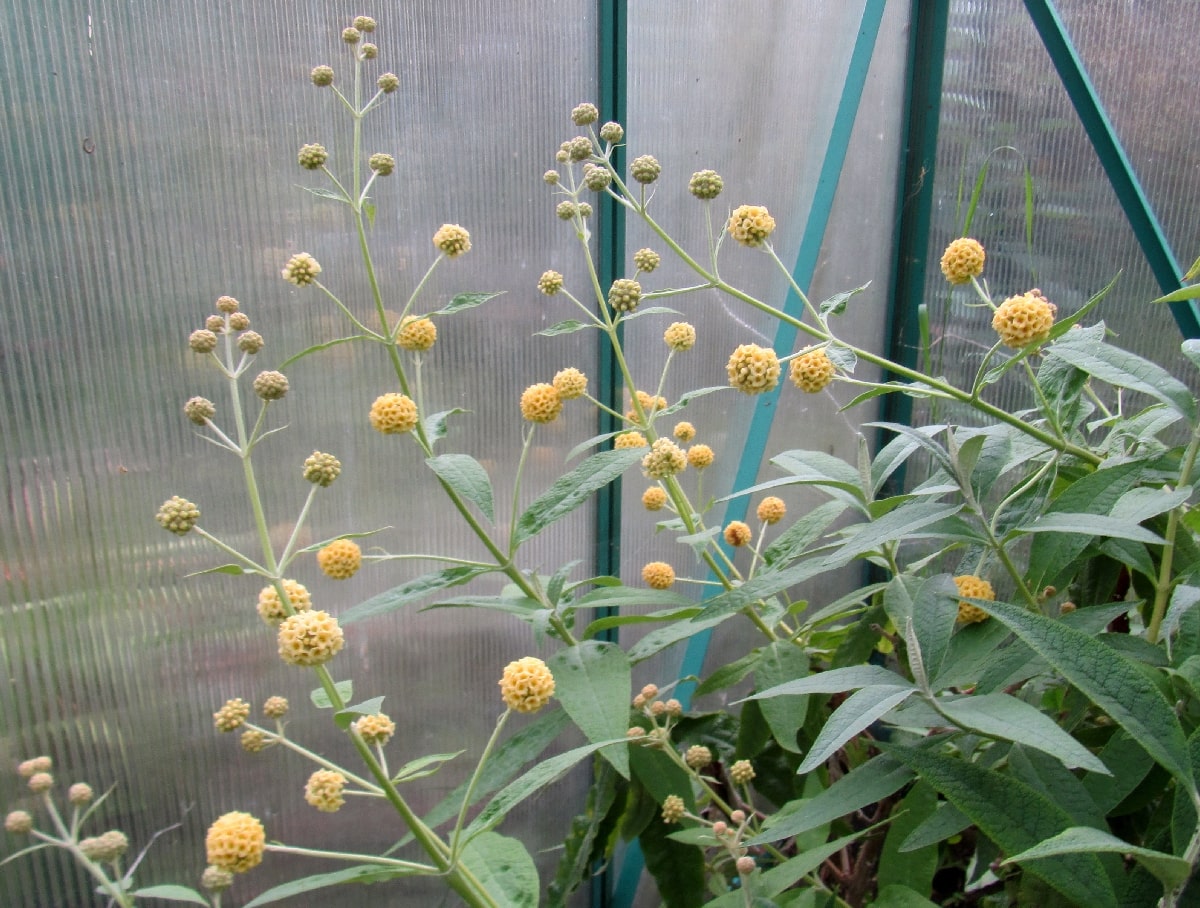
B. globosa HCM 98017 has pale yellow flowers.
Open full size image in a new window

Yellow-flowered B. globosa. 'Kevin' is one of my own creations.
Open full size image in a new window
The scent of the flowers is more or less the same in all the various cultivars: to my nose, a mixture of dandelion flowers and honey. Regardless of gender or colour, all types bring in the bees in great numbers, so this scent must be attractive to them, and B. globosa a valuable source of nectar in the late spring.

B. globosa is very attractive to bumblebees, even the pale-coloured HCM 98017.
Buddleja araucana Phil.
Synonymous species:
Buddleja nappii Lorentz; Buddleja globosa var. araucana (Phil.) Reiche.
Buddleja araucana, which is often still labelled with its synonym Buddleja nappii, is a species very similar to B. globosa, so similar it was once described as a variety of B. globosa.B. araucana was named by R. A. Philippi in 1873, after the Araucania region of Chile, which is also home to the monkey puzzle tree (Araucaria araucana).
The two species' ranges do not have a significant overlap, although contiguous. B. globosa comes from the Andes, whilst B. araucana is found more to the east of Chile and into Patagonia (Argentina). In the wild B. araucana is something of a xerophyte, living in dry regions, whereas B. globosa is found in areas of higher rainfall. The divergent habitats might accentuate the differences; it's likely the soft life in England makes B. araucana appear much more like B. globosa than in its natural habitat.
Most of the specimens in the UK are derived from a shrub grown at Kew Gardens in London, and this is possibly the same plant once grown at the Royal Botanic Gardens, Edinburgh. I believe this cultivar to be male.
I can only base my opinion on this single specimen, but it can be distinguished from the B. globosa plants in cultivation. It may flower a little earlier in a typical year, but this is insignificant. The physical differences include a smoother, more leathery appearance to the narrower leaves when compared to the bullate leaves of B. globosa, and a more conspicuous indumentum on the branchlets, underside of the leaves and the flower-buds. The flowers are not identical, with an altered shade of orange and petals of a different shape. The most compelling difference comes with the flower-buds, which a distinctly pointed and bullet-shaped when compared to the rounded B. globosa buds.
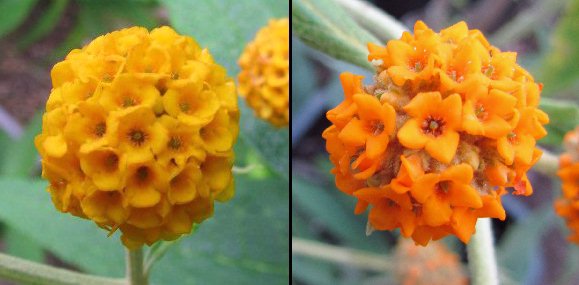
The flowers of B. globosa (left) differ from those of B. araucana (right).
Although intermediates or hybrids are unknown in their native ranges, even where they overlap, I’ve had no trouble crossing the two species. The progeny are intermediate, such as in this example; the already minuscule differences mean the hybrids are practically indistinguishable from B. globosa. I suspect a future revision of the Buddleja species from the Americas will once again reduce B. araucana to varietal status or even to a synonym of B. globosa.
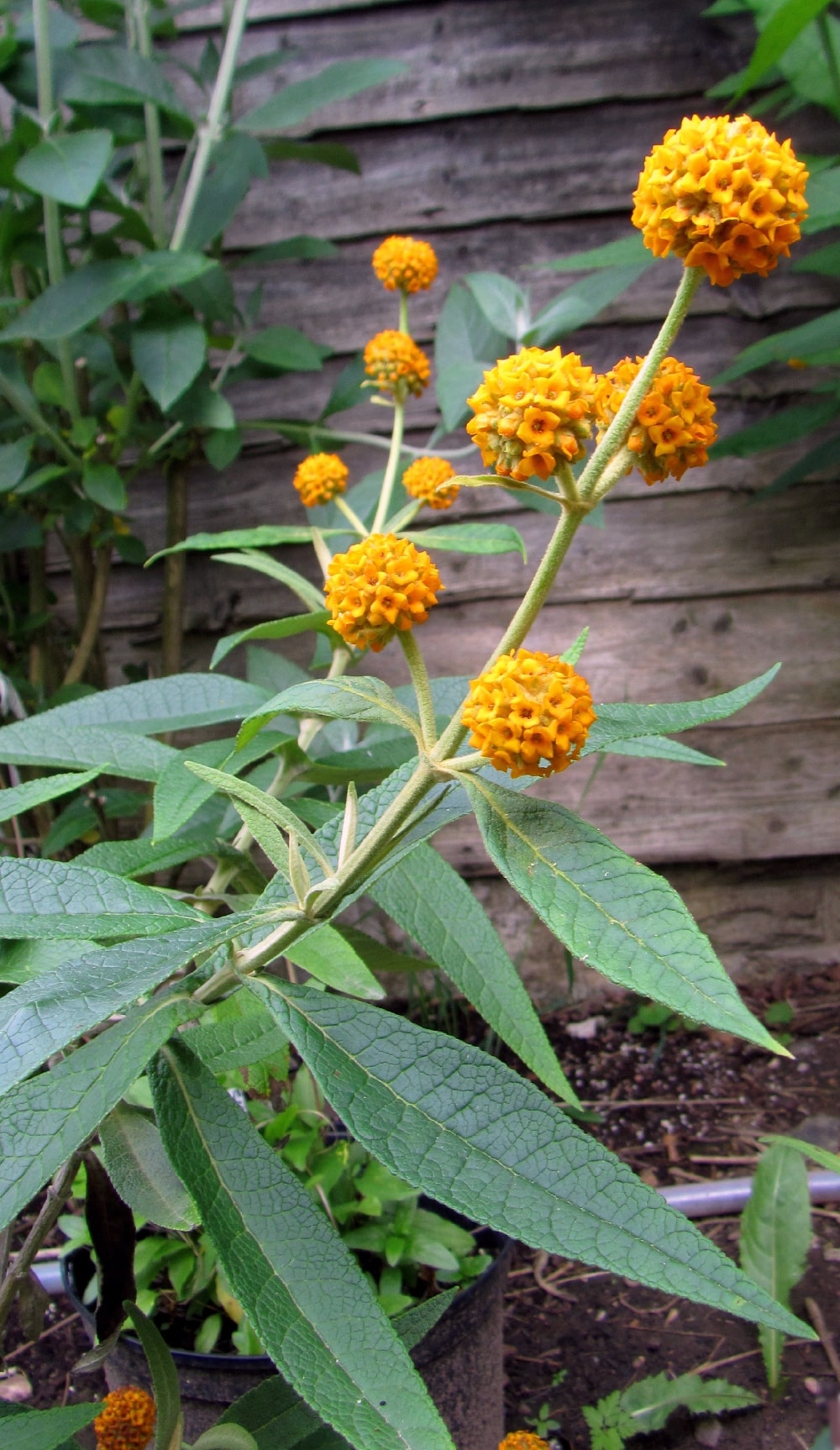
The inflorescence and leaves B.
araucana. The cultivated form is male.
Open full size image in a new window
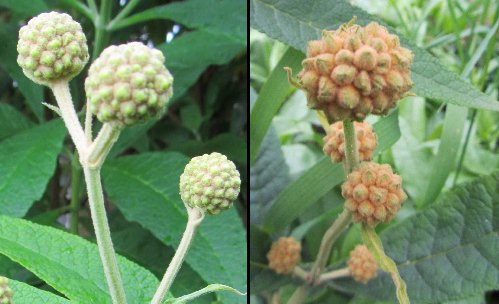
The buds of B. globosa (left) compared to those of B. araucana (right). Note the different shape and brown fuzz on B. araucana.
Garden Hybrids
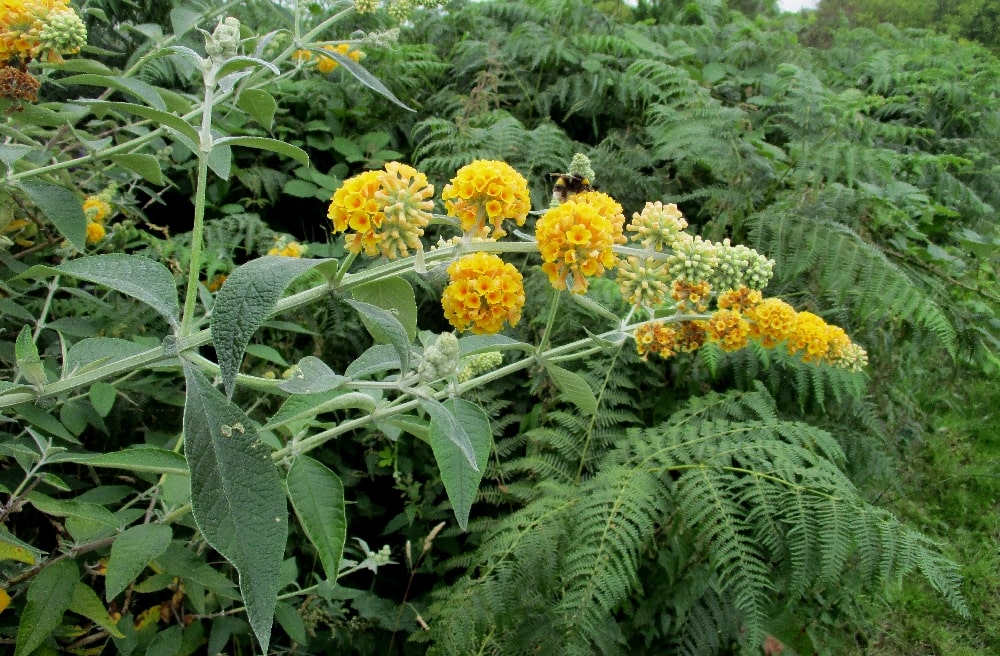
B. x weyeriana 'Honeycomb', a hybrid of B. globosa and B. davidii.
Open full size image in a new window
Both B. globosa and B. araucana are able to hybridise with other Buddleja species, including those from Asia. The popular Buddleja x weyeriana cultivars are F2 hybrids of B. globosa x B. davidii, i.e.: (B. globosa x B. davidii) x (B. globosa x B. davidii).
Salmon Spheres is a cross of B. globosa with B. crispa, and has felted foliage and pink-flushed yellow flowers in loose globose heads. It flowers both spring and autumn and has proved fully hardy over several winters. Winter Sun is B. officinalis x B. araucana. It's an unsual plant, a large and vigorous shrub with large glaucous leaves. The flowers are yellow heavily flushed with lilac, and they appear very early in the growing season, February-April; it only flowers reliably if the winter has been mild, although it has proved pretty hardy otherwise.
Determining the Gender
As mentioned above, both these species are dioecious and it is often hard to determine the gender of a plant. I have observed the males flowering up to two weeks before the female, although I am working with a small sample. Possibly this has evolved to ensure that the pollen is available to the female flowers immediately upon opening. Assuming compatible pollen is available, female plants will set seed. Identifying a male plant may be possible using only a hand lens.
In the photos (left) the female flower does not appear to have stamens; although these are present, they are withered and brown with no apparent pollen being shed. HCM 98017 has pale yellow bi-lobed stamens much the same colour as the corolla and with visible pollen being shed. The unnamed male plant conveniently has bright white stamens that are much more visible. The cultivated B. araucana is also male, but the stamens are orange and difficult to see, not only due to the colour being the same as the corolla but also because the corolla tube has more hairs within. All have a similar shiny green stigma that is redundant in the males.
These features should be easier to see on the Supersized Image.
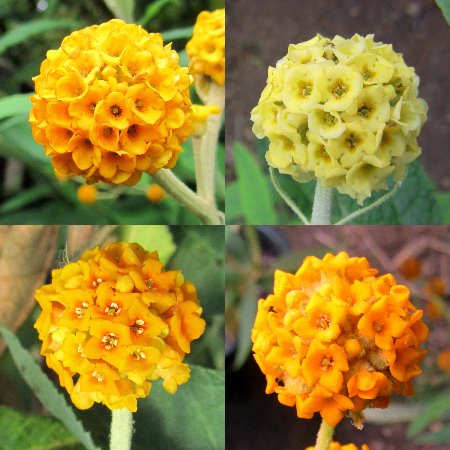
B. globosa flowers: female (top left); the male HCM 98017 (top right); un-named male (bottom left); and male B. araucana (bottom right).
A supersize version is available here
References
Norman, E. M. (2000). Buddlejaceae. Flora Neotropica 81. New York Botanical Garden, USA.
Stuart, D. (2006). Buddlejas. RHS Plant Collector Series, Timber Press, Oregon, USA.
Email:
buddlejagarden@gmail.com
© The Buddleja Garden 2011-2025.
